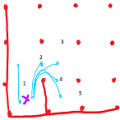Flexible shields for micromouse sensors
Micromouse sensors need shielding to work at their best. Here we are going to show you how to make a simple, flexible light shield for your micromouse sensors that will cut down the effect of ambient light and reduce leakage from the emitter. The problem with micromouse sensors The common…
